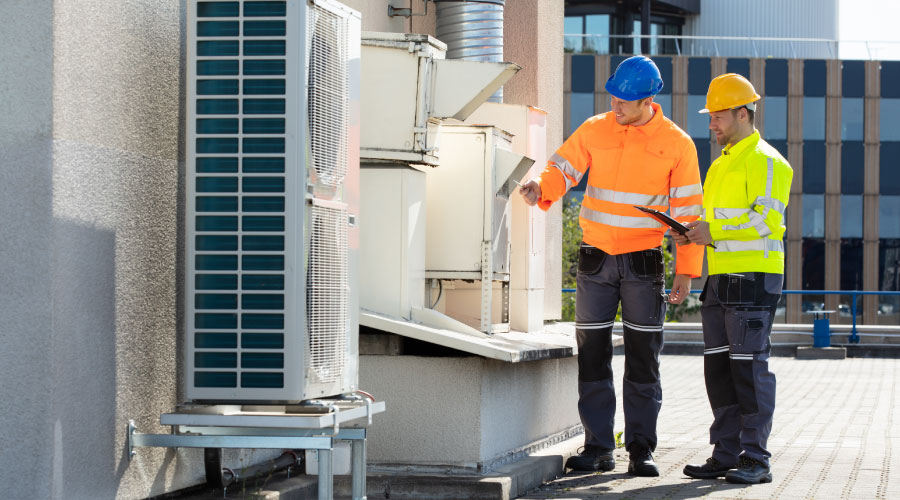RISK?
Experts fear a CBR attack, but can't say when, where or how.
Inside, steps facility executives should consider now
The Murrah Building in Oklahoma City. A nightclub in Bali. The rail system in Madrid. The subway in London. For all their differences, those deadly attacks have one thing in common: The instrument of terror was a bomb. Even on Sept. 11, terrorists used aircraft as missiles that exploded when they struck their targets.
Those attacks helped to produce a new era of security measures for buildings. Some steps are intended to prevent terrorists from gaining entry to a building; others are designed to harden a building against an explosion outside. But bombings are not the only threat a building may face. As the sarin gas unleashed in a Tokyo subway in 1995 and the 2001 anthrax attacks showed, the risk of chemical, biological or radiological weapons cannot be discounted.
How seriously should those threats be taken? Fortunately, terrorist attacks against buildings in the United States are rare. But that fact will be of little comfort should an attack occur. Many experts contend that another attack is all but certain, but none can predict when, where or how the attack will occur.
The opportunities for terrorists to use chemical agents against the American public exist almost everywhere. Chemical production plants, manufacturing facilities that require industrial chemicals, and even municipal water-treatment plants are all potential targets.
But even those facilities without the need for chemicals are hardly immune. In the case of water-treatment plants, the chlorine used to purify city drinking water is usually transported to the facility by train — oftentimes through the heart of a city. Train tankers carrying chlorine could be detonated en-route, sending up a plume of toxic chlorine gas. (See box below.)
“What frightens me most are industrial toxins that get into the wrong hands,” says William Bahnfleth, the founding director of the Indoor Environment Center at Penn State University.
Often, the constituent ingredients for chemical bombs are easy to come by, and they can be weaponized more easily than biological agents. Many chemicals also have long shelf lives. These factors indicate chemicals to be a good weapon choice for terrorists.
“Chemical weapons could be made by anyone with a rudimentary knowledge of chemistry, using recipes that are available on the Internet and other published sources,” says Wladyslaw Kowalski, a professor of aerobiological engineering at Penn State.
Kowalski believes that the most likely buildings to be attacked with chemical weapons would be large office buildings, sports arenas or crowded malls.
Biological weapons are a different story. With the exception of anthrax, biological microbes are difficult to grow.
Anthrax remains a threat, largely because it is one of the easiest and deadliest microbes to grow in a lab. But a lab isn’t necessary. In fact, anyone with a cattle farm can grow anthrax.
“History has shown us that anthrax is an effective bioterrorism weapon because the bacterial spore is very stable and storable,” says Sean Ahrens, senior security consultant with Schirmer Engineering.
The physical structure of the anthrax spore largely explains its hardness. The core of the microbe is wrapped in a protective sheath. When the microbe lodges in an organism, the protective outer layer melts away, and the microbe begins to work.
A small number of other agents, such as hantavirus or bubonic plague, also occur naturally and might be harvested to a limited degree from animals in the wild or in animal facilities. But other biological threats are a distant second to chemical threats because of the extraordinary difficulty of weaponizing bacterial pathogens.
“Even with a laboratory, terrorists would have a difficult time growing pathogenic microbes,” Kowalski says. “Toxins, like botulinum toxin, might be easier for would-be terrorists to create and use than any microbe.”
These toxins could be dispersed into the ventilation systems of buildings, dusted around malls, or mailed. Kowalski believes there will be more mailings of toxins and dry bioagents in the future, but not in large quantities and not as military-grade weapons.
Identify Threats
Many facilities have hardened their perimeters to prevent bomb-carrying trucks from crashing through the front lobby. Measures have included placing concrete bollards, large planters, and other vehicle barricades at the edge of properties.
But countering biological or chemical contamination threats are much more difficult. Retrofitting existing buildings with CBR countermeasures is cost-prohibitive for all but the most high-profile targets, so many security experts recommend drafting preparedness plans instead.
“Put yourself in the mindset of a terrorist,” says Ahrens. “Imagine having to defeat security controls.”
The first step is to conduct security and threat assessments.
“The most important thing to do is identify vulnerabilities,” says Bahnfleth. “Building owners need to identify threats and inventory the likelihood that any one of them will be exploited by terrorists.”
This process is difficult because there are such a wide variety of terror options available to attackers. Nevertheless, it’s important to determine what threats exist near a facility. Among the questions to ask:
- Do trains or tanker trucks carrying hazardous chemicals rely on routes adjacent to the property? Is there another facility nearby that uses or produces large quantities of industrial toxins?
- In the event of a contamination external to the property, what steps can be taken to mitigate the danger to the occupants of the facility?
- How quickly can staff shut off the ventilation and HVAC system?
- If an occupant in the building discovers a suspicious substance or package, what precautions are necessary to quarantine the area?
- If facilities or environments adjacent to a building pose a risk that is beyond the control of the facility executive, what can be done to reduce the threat? For example, is it possible to partner with the security director at the nearby chemical plant and share information or surveillance tapes?
Reduce the Threat
Once the risk has been identified, the next step is to reduce the threat. The American government increasingly relies upon what it calls “humint” — military-speak for human intelligence. Facility executives should consider doing the same thing.
That doesn’t mean relying on spies. Ahrens recommends empowering the staff in facilities to take note and report threats.
“People can say, ‘There’s something wrong here,’” Ahrens says. “These days, security is everyone’s business.”
But getting staff in any facility to routinely identify and report problems can be unreliable, particularly when staff are afraid of “crying wolf.”
This is no small consideration for facility executives. Every interruption or disruption can cost an organization valuable time, money and efficiency.
Moreover, unless properly conditioned, people tend to be optimistic, dismissing potential threats. This is problematic. Often, people are unwilling to believe that they (or their organization) are vulnerable to terrorism. In other words, they need to come face-to-face with the problem before they are fully cognizant of the threat.
William Sako, a security consultant and president of Sako & Associates Inc., recommends that facility executives overcome this tendency with regular security meetings. “The challenge is to maintain a state of heightened awareness even in times of relative calm,” he says. “This is done effectively through signage, the presence of security, and regular security briefings and meetings with building tenants.”
Sometimes, facility executives also need to rely upon technology to protect buildings and occupants. However, rather than install CBR-specific countermeasures in existing buildings, Bahnfleth recommends cost-justifiable fixes that both mitigate terrorist threat and benefit the larger aims of the organization.
Facility executives need to weigh one investment against others, Bahnfleth says. For example, rather than invest in special filters or air-quality sensors, he recommends investing in the HVAC system itself.
It’s no secret that HVAC systems are the best choice for distributing chemical or biological contaminants within a building. So when facility executives commit themselves to knowing intimately the operations of their HVAC system, they are better prepared to know exactly what to do if and when a biological or chemical terrorist attack occurs. At the same time, better knowledge of the HVAC system will help facility executives improve system operations.
A new building gives facility executives more choices. “Retrofitting buildings with protective systems can be an expensive option,” Kowalski says. “Facility executives should be aware that chemical and bio-defense systems can be designed into new building construction projects at a far lower cost than in retrofits.”
Facility executives should also consider security systems that limit access.
“Focus on closing off or restricting access to entry portals, such as loading docks, mail rooms and physical penetrations for HVAC and MEP systems,” Sako says. “Controlling who goes where and when is the foundation of a good building security program.”
A NEW THREAT?
Trains and Tankers as Weapons?
Chlorine gas is a World War I-era weapon, serious enough that the federal government has labeled it a weapon of mass destruction. It’s also widely used, for everything from water purification to production of plastics, paper and pharmaceuticals. Some observers fear that shipments of chlorine could become a target for terrorist groups. One of those concerned is Fred Millar, director of the Target Cities Re-Routing Project for advocacy group Friends of the Earth. He says that the easiest, most effective way for terrorists to kill Americans is by attacking chlorine shipments carried into and through one of the 37 major target cities identified by the Department of Homeland Security.
“If terrorists were to detonate one standard 90-ton chlorine tank car,” says Millar, “it would create a poison gas cloud 411/2 miles in length, and four miles wide.”
Federal statistics on the deadly nature of chlorine gas are frightening:
- A toxic gas cloud release could be lethal to people within up to 15 miles of the tracks, depending on the wind direction.
- The U.S. Coast Guard estimates that a chlorine gas cloud can spread two miles in ten minutes.
- The U.S. Naval Research Labs has testified that just one chlorine tank car’s cloud could kill 100,000 people in 30 minutes.
“It's a low-tech way for terrorists to use our own infrastructure against us,” Millar says.
Millar hopes for federal government mandates that re-route chemical shipments by rail and highway. “We cannot leave it up to the chemical shippers, railroads and truckers to decide that it is okay to risk a major release of toxic chemicals in dense urban areas.”
In the absence of federal routes, six major target cities have introduced local re-routing ordinances to eliminate the risks of truck and rail shipments of materials that are considered weapons of mass destruction. Washington D.C. has enacted such a law, and target cities such as Cleveland, Baltimore, Chicago, Boston and Philadelphia have introduced them as well.
The railroad industry argues against local regulations, fearing different cities might ban shipments of different chemicals. Railroads also argue that federal studies did not identify rail shipments of hazardous materials as a major vulnerability.
— Loren Snyder
|
EMP BOMBS
From Sci-Fi to Real Threat?
Security experts are concerned about terrorist deployment of an electromagnetic pulse weapon (EMP). When detonated, EMP bombs produce a high-density electrical field of gamma rays that does irreparable damage to electronics and microcircuits. In an increasingly digitized society, a truck loaded with an EMP bomb might cripple financial networks if detonated in lower Manhattan.
Estimates indicate that a single EMP detonation 200 miles above Kansas could affect electronics throughout the contiguous United States. While EMP scenarios largely have been the domain of Hollywood action movies, Popular Mechanics magazine and a handful of Internet sites have published technically accurate plans to construct a crude EMP weapon. The design plans use technology available since the 1940s, and total cost for a rudimentary but very effective EMP is approximately $500. The only protective recourse to an electromagnetic pulse (which also occurs during nuclear explosions) is to switch off electronics or place them in “hardened” Faraday cages.
— Loren Snyder
|
What To Remember
Facility executives can reduce CBR dangers against facilities by remembering a few truths:
- Because knowing is half the battle, be aware of security risks.
- Rely upon the people within an organization to report suspicious activity.
- Controlling access is the best preventive measure.
- There’s a spectrum of groups that could pose threats, each with its own agendas.
- And finally, when it comes to terror threats, consider every angle.
“Terrorists have a different way of looking at their methods,” says William Bahnfleth, Indoor Environment Center, Penn State University. “They don’t necessarily have to do a lot of damage to be successful. All terrorists have to do to achieve their goal is instill fear in the population they target.”
Wladyslaw Kowalski, professor of aerobiological engineering at Penn State agrees. “Perhaps the most unfortunate lesson being learned from the urban warfare going on overseas is how effective terrorism is at causing chaos and paralyzing traditional military forces,” he says. “The evolving methods and weapons of the insurgents are surely not going unnoticed by enemies elsewhere and by domestic extremists within our borders. It may sound trite, but what goes around comes around, and we need to be prepared.”
— Loren Snyder
|
Loren Snyder is a freelance writer and former managing editor of Building Operating Management.
Related Topics:











